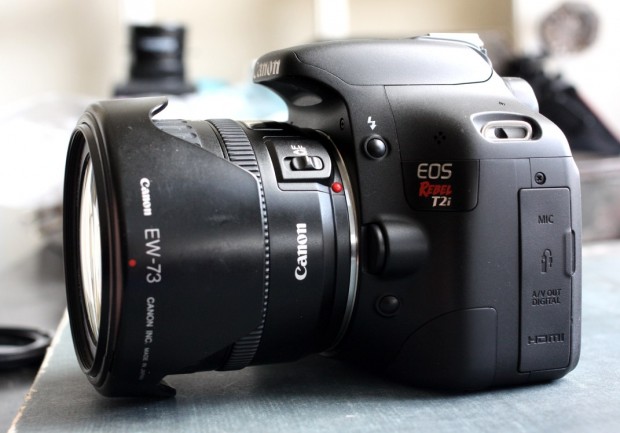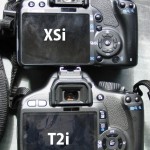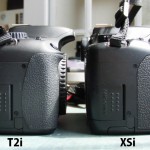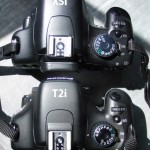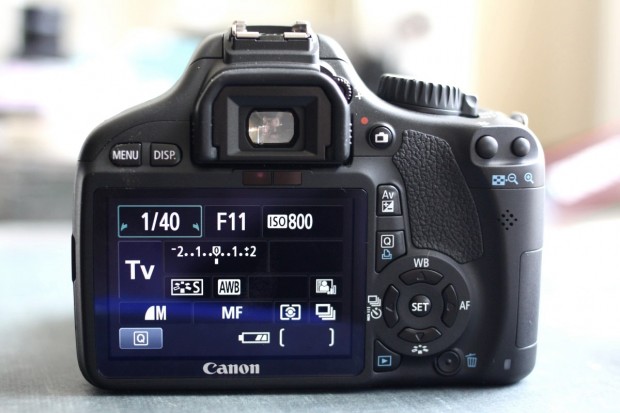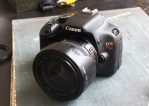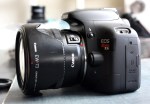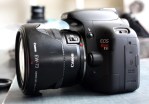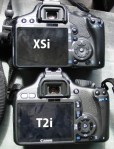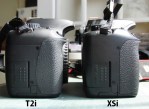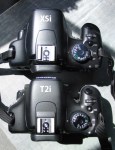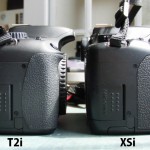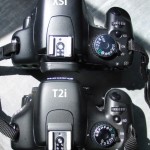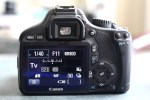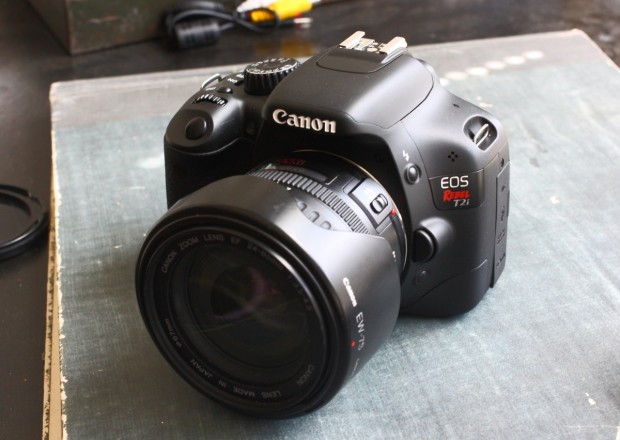
Short version: An outstanding consumer DSLR and liberating video recorder, the T2i is a powerhouse media device in a small and relatively affordable package. What I think of as killer features, however, may not be viewed as such by the buying population at large.
Features:
- 18-megapixel images/up to 1080p video
- ISO 100-6400
- 3″ high-resolution LCD (1040K dots/720x480px)
- Mic in and HDMI out ports
- MSRP: $800 (body only)
Pros:
- Great image and video quality
- A better camcorder than “real” camcorders at similar prices
- Beautiful LCD
Cons:
- Compact body isn’t for everyone
- Built-in flash is limited; AF strobe is a pain
- Could really use a thumb wheel
Full review:
Let me just, right off the bat, say that for serious image quality comparisons, you should head over to DP Review. I don’t have the kind of setup necessary to test chroma levels between seven different cameras at once. This review, like all our reviews, is more anecdotal than analytical. From what I’ve seen (and read), the T2i’s image quality is comparable and sometimes better than the other cameras at its price level, depending of course on the lens. I put a pair of unmodified sample shots (RAW –> JPEG) here, but the image quality of DSLRs at this level is pretty solid across the board.
But to continue: the T2i is a camera I’ve been looking forward to for a long time, I freely admit. I bought the Rebel XT, skipped the XTi, bought the XSi, and skipped the T1i. They were clearly onto something with DSLR video, I thought, but it needed more time to mature. I think the T2i is the fulfillment of the promise made with the T1i. While it’s clearly a consumer camera, it’s extremely versatile piece of electronics, almost as much so, I feel, as the Casio Exlilim FC-100 (my favorite compact camera).
Its main selling features are a highly improved LCD, a more complete video mode than its predecessor, and of course an increase in megapixels. Other than these features, the T2i is pretty much still the Digital Rebel we know and love. At $800, it’s not exactly an entry-level camera, but for enthusiasts and casual moviemakers, it’s a huge value.
The body is almost identical to earlier rebels, and slightly thicker than my XSi. the other changes I noticed are largely shared with the T1i: molded buttons instead of circular, a more aggressive cut to the hand grip, and a dedicated live view button. I found the dials to be a little bit stiffer than on my XSi, but they’ll probably loosen up with use. And is it just me, or is the movie mode at the wrong end of the dial? Maybe they should have it on both ends.
The new LCD is a smart move on Canon’s part: the T1i had a similarly high-resolution screen (this one is 720×480), but the new 3:2 aspect ratio means your photos will no longer be cropped or letterboxed when they’re displayed. If you haven’t experienced the new resolution, get ready for a treat; I’ve spent a lot less time zooming into my pictures to check focus than I did on my XSi or other DSLRs. Other than that, the interface seems unchanged, and as before the D-pad is only just sufficient for navigating your photos. I know it’s considered a high-end feature, but a thumbwheel would go a long way towards making this camera more fun to use.
The pop-up flash is still really only useful for snapshots, and flash focusing in low light produces the strobe effect familiar to Canon shooters, dazzling your subjects and giving them a confused look in the actual exposure. But if you’re really serious about flash photography, you probably already own a Speedlite or some such.
The new 18 megapixel sensor certainly creates larger images, and low light performance is improved somewhat over the T1i. I still recommend setting the ISO manually to avoid unnecessary noise. As I mentioned before, image quality is best tested systematically, and DP Review has that covered. Other general photography tips can be found in forums and other reviews.
Video is really the fun part of the T2i. Within seconds of trying shooting 1080p at 24 FPS, I knew the T2i was a winner. If you put a reasonably fast lens on the camera, with a decent focus ring, you’ll feel like a serious filmmaker in no time. The fidelity, sensitivity, and ease-of-use are off the chart; there are plenty of perfectly nice little camcorders out there right now, but the fact is that their image quality is pretty rotten, and low light performance is just plain terrible across the board. I’ve said some things about DSLR video, and I stand by them, but for anything less than a professional production, a T2i or 7D (or K-x or other brand of video-shooting DSLR) is a great option.
It is important that you actually want to do more than the average Flip camera. If all you want is a single button and automatic YouTube uploads, of course a $100 pocket cam will be sufficient. But for those of us frustrated by the annoying interfaces and limited customizability of current camcorders, something like the T2i is a dream come true. A few minutes of experimentation had me changing settings like a champ, playing with depth of field, manual follow focus, and so on. I won’t bore you details of the cinematic experiments I attempted, but in almost every case I’ve found that the T2i acquitted itself wonderfully. You can watch a sampler video below, but to see it in high definition please click here!
I shot mostly at 1080/24p, but you can also shoot at 720p or 640×480, though both are inexplicably limited to 60FPS. I have no idea why that is, but it’s annoying. If people ask for it, Canon might consider putting alternate frame rates into a firmware update, but at the moment it is worth consideration if you care about that sort of thing. There’s still plenty of skew when you move the camera around quickly, which is something that’s hard to explain but you’ll notice it during playback. It’s a flaw shared by most non-pro digital video cameras, and Canon’s is better than Nikon’s right now, but it’s something to be aware of. Other than that, I found video quality to be quite good and not too affected by encoding artifacts. You’ll get some smearing, of course, but that’s the same for any device recording live to H.264. Check out this frame grab from a video that was taken in the middle of the night (late ferry) — there’s very little noise to speak of and yet the darks are dark and the brights are bright.
Keep your workflow in mind (and final product too) when shooting — I found that my computer would crash when trying to re-encode a bunch of 1080p/24 under certain circumstances, and of course most web video has 720p/30 as a reasonable maximum.
I stuck with manual focus throughout the review, despite the wimpy focus ring on my 35mm F/2, because the contrast-based autofocus is too slow for any kind of action. It was accurate, sure, but you don’t always have the luxury of a spare five seconds in which for it to work itself out, when it could be as simple as a twist of your hand. The other option, which flips down the mirror for an instant, is loud and unreliable. I’m sure they’ll be improving that sometime, but probably not any time soon, so if you’re uncomfortable using manual focus for video, I’d stick with the fixed focus pocket cams. They’re still great for a ton of stuff, and they’re a lot cheaper.
The downside of shooting video is pretty obvious: it drains your battery and fills up your card extremely fast. SD cards are cheap these days, but in my newfound love for high-definition video, I’ve already started filling up the hard drive on my laptop. It’ll be a while before I get that under control. One minute of 1080/30p took up about 340MB, and the lower-end VGA/60p video was a little less than half that.
The combination of a cropped sensor and no image stabilization means that your video will probably be pretty shaky. I’d recommend picking up a cheap, portable tripod or monopod, or looking into DIY stabilization solutions. If you don’t have a 1080p-capable monitor either, you might want to pick one of those up too. You see? It’s kind of a gateway drug.
You’ll also want to think about getting an external microphone. The on-camera mic is tiny and records in mono; sound quality varies widely and the best thing to do is to just get a small one that perhaps clips onto the hot shoe.
Conclusion
The T2i is a great success and a great value. I know I’m biased as a Canon shooter, but I think it really is the best value on the market right now for an all-purpose imaging device. Stills are excellent, video is fun. As long as you are aware of the shortcomings of digital video in general and DSLR video specifically, this is a great buy for a home video connoisseur. Beyond the improved video and body, it’s the same winning Rebel formula, backed by the same great Canon lens selection. Seriously though, if you want to shoot great video, get a fast prime with a big focus ring. It’ll hurt at first but you’ll thank yourself later.
Product page: Canon Rebel T2i DSLR (also known as the 550d or Kiss X4)
